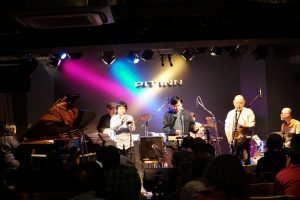Jazz and not-jazz, just provocative fun
Satoko Fujii 藤井郷子and Natsuki Tamura 田村夏樹
Pit Inn, ShinjukuJanuary 13, 2019
Natsuki Tamura & Satoko Fujii whole day concert “Aremo Koremo” あれもこれもDuo
Yoshino 与之乃 - 薩摩琵琶 Satsuma biwa, vocals
Natsuki Tamura 田村夏樹 - trumpet
Otoshidama
Koichi Makigami 巻上公一 — voice, theremin
Natsuki Tamura 田村夏樹— trumpet
Junji Hirose 広瀬淳二—tenor sax
Satoko Fujii 藤井郷子—piano
Mitsuru Nasuno ナスノミツル—bass
Yasuhiro Yoshigaki 芳垣安洋—drums
Takashi Itani 井谷享志—drums
Natsuki Tamura and Satoko Fujii like to make music in their own unique way. Is it jazz? Not quite jazz? Whatever category your try to make it fit, they always make it provocative and fun. And long! On the second Sunday of the new year, they made music for about eight hours straight! With only a few short breaks, they showcased five unique combos with some of the best musicians in Tokyo. It was the perfect way to ring in the new year.
Arriving in time for the last two sets, the stage became a dueling contest of old and new, tradition and anti-tradition, western and eastern. Yoshino on biwa and vocals spun out stories in as traditional a mode as one can find on any Japanese hogaku stage, while Tamura punctuated the stories with a range of trumpeting that was just as vocalic, if not as traditional. But then, what does ‘traditional’ really mean?At least in part, it meant surprising, startling and engaging interplay. The biwa felt like an instrument suited for free improvisation and the trumpet felt like it has been used since ancient times in Japan. With nary a 4/4 rhythm in earshot, the two were free to build a sonic bridge over chasms of musical distance.
After a short break, “Otoshidama” jumped into their first work, “Chain.” Beginning with drums and sax, which was passed on to sax and theremin vocals, which then was passed to theremin vocals and trumpet, to trumpet and piano, piano and bass, bass and drums, and then drums and drums, the chain was easy to follow visually and fascinating aurally. The chain then circled back counter-clockwise, two by two. Each of the matchups became intriguing in itself, the other musicians no doubt restraining their itch to interact with someone across the chain. The song slowed down for observation the chain of connections every group creates, exposing it for the magical link a group’s connections make.
“Stop and Go” opened with wild drumming and a powerfully clean sound that stopped and went over to add a dash of funk and then a slathering of hard bop. Like “Chain,” “Stop and Go” opened up for observation an essential side of all music, when and where the music stops and goes. Stopping and going between genres, tempos, commonalities, and feelings, the song worked with space, openness and the delight of unexpected change as much as with chords, rhythms and harmonies.
The first set finished with a piece called “Eight Minutes.” I doubt anyone in the audience was timing it, or even looking at their watches, but somehow calling out the song as eight minutes fit perfectly. Of course, the minutes flew by inside Fujii's and Tamura’s world of magical improv, where time flows with its own wild currents and the title of any song is suffused with multiple ironies.
The encore was a powerful full-on free improve. Too intense to think about, you just grab on and enjoy the ride. That was easy with these musicians who are so used to playing freely, strongly and comfortably.
Fujii and Tamura’s jazz—and please, choose your own word for this marvelous music—works because it is not all from the head, it’s really from the heart. Their music is powerful to the extent that it defies language to describe it. That lets them get beyond language and deeper into an essentially playful spirit that makes their music so special.
Satoko Fujii homepage
Satoko Fujii previous CD review
Satoko Fujii Big Band
And more on Satoko Fujii and Natsuki Tamura here




